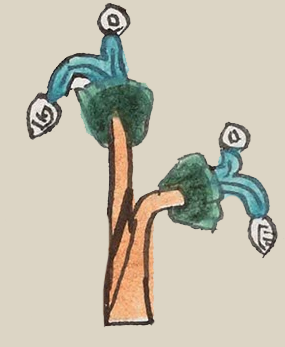ahuatl (Mdz40r)
This element has been carved from the compound sign for the place name, Ahuatzitzinco. The sign features an oak tree (ahuatl) with a leader and one additional branch (bending to our right). The green foliage at the end of each branch has water spouting from it. So, this is an element from a compound glyph, but it still has two elements and a downward reading order.
Stephanie Wood
The ahuatl (oak tree) is something of a compound glyph in itself. It is a fairly generic tree that might be taken for cuahuitl except for the spouting water from the greenery. Normally, the trees that have the black diagonal stripes running across their trunks are meant to be read "cuauh" (from cuahuitl). This is an exception.
Stephanie Wood
c. 1541, but by 1553 at the latest
Stephanie Wood
trees, oaks, ahuatl, water, shells, encinos, robles, agua, caracoles

ahua(tl), oak tree, https://nahuatl.wired-humanities.org/content/ahuatl
a(tl), water, https://nahuatl.wired-humanities.org/content/atl
oak tree
el roble
Stephanie Wood
Codex Mendoza, folio 40 recto, https://digital.bodleian.ox.ac.uk/objects/2fea788e-2aa2-4f08-b6d9-648c00..., image 90 of 188.
The Bodleian Libraries, University of Oxford, hold the original manuscript, the MS. Arch. Selden. A. 1. This image is published here under the UK Creative Commons, “Attribution-NonCommercial-ShareAlike 3.0 License” (CC-BY-NC-SA 3.0).


